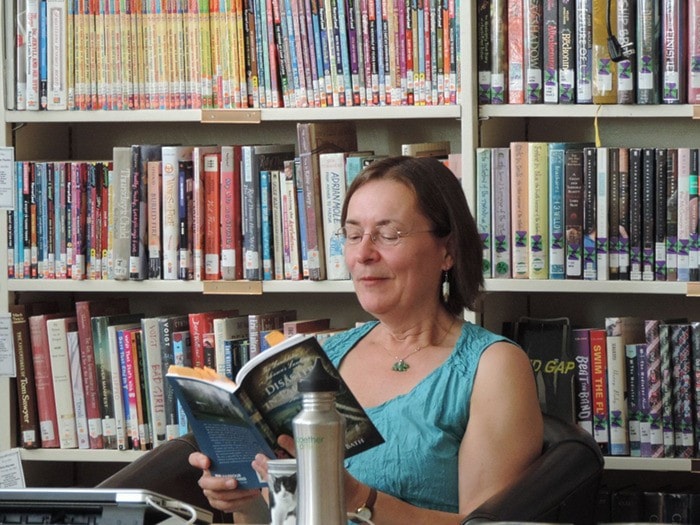RYAN WILLMAN
Arrow Lakes News
Making the first stop on her book tour, Amanda Bath visited the Nakusp Public Library on June 15 to share her experience as a survivor of the Johnson’s Landing slides in 2012 and to promote her memoir, Disaster in Paradise: The Landslides in Johnson’s Landing. The tour will continue over the course of two weeks, first circumnavigating the Kootenay region, then returning closer to home for the final leg.
Starting with a slide show that included a personal collection of pictures and a series of aerial shots of the devastated area along the Kootenay Lake, Bath introduced the audience to the community of Johnson’s Landing and its residents. The picturesque photos of colorful yards and fairy-tale waterfalls juxtaposed with the horrors of the aftermath caused by the slide. This contrast provided a stark context for the memoirs and a sense of place for the reading selection Bath shared from her book.
“This book is a love story,” Bath explained. “You wouldn’t imagine it, but it is a story about the love of place, the love of people, pets and your belongings. And it is about the things that help define you, the things around your home that make you who you are and then having all of that swept away in about 45 seconds.”
Reading her own words, Bath shared a passage that described her fortunate escape from the second slide when she had returned to her home in an attempt to find her beloved cat.
The Nakusp Library was engulfed in silent anxious awe as Bath’s words detailed her chartered boat ride across Kootenay Lake almost 24 hours after the first slide, and finished with climaxed sighs of relief as the boat carrying Bath and her companions pulled away from shore just as the mud and debris destroyed the rest of her home and hit the water.
Bath used the writing process as a form of healing from the trauma of the event and it got her through what she described as “a very, very dark time” and is humbled by the reception that her work has been receiving.
“It was a therapeutic thing because I had very nearly been killed. We had lost our house, our cat, and our belongings. Everything.” Bath said. “But what I didn’t expect was that for other people, reading my book acted as a sort of therapy for them as well. In some cases they have been holding grief for a very long time and this book is a story of the journey through grief, with the hopefulness of healing at the end of it.”
When she started writing, Bath did not have a book in mind, but decided that she needed to start making notes to help remember events that would otherwise be muddled by stress and trauma. The journaling exercise evolved and took shape, and finally reached a point when she felt satisfied her story had been told. When an editor was consulted it was suggested Bath interview other people because, as she said, “mine was, obviously, not the only story.”
Bath embarked on a two year, five draft journey that spanned interviews from 35 people including both residents of Johnson’s Landing and outside agencies such as RCMP, BC Search and Rescue, the BC coroner’s service, and even one of the excavator operators.
“That then created a rounding out of the story,” Bath concludes. “My memoires are part of the story, but it is more complete now.”
